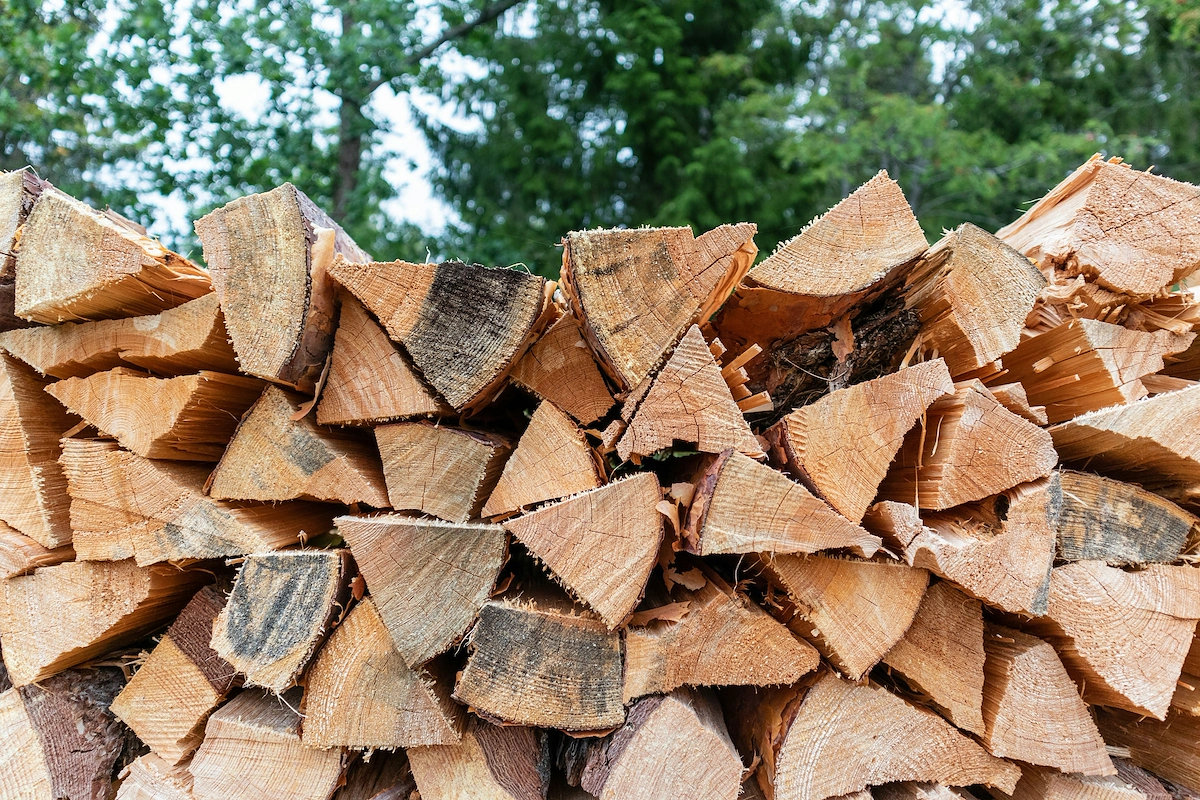Starting a firewood business is a rewarding venture that blends hands-on work with smart business planning. It's a surprisingly large market, with steady demand for quality firewood for home heating, backyard fire pits, and even local restaurants.
This guide will walk you through the practical steps of securing permits, finding suppliers, acquiring the right equipment, and choosing a location to help you launch a successful firewood business in the U.S.
Step 1: Plan your business and validate your market
Market and competitor research
First, understand your local market. Check platforms like Facebook Marketplace and Craigslist to see what a cord of seasoned hardwood sells for in your area. Prices can range from $250 to over $500 depending on location and wood type. This research helps you avoid the common mistake of underpricing your product.
Next, identify your competition. A simple search on Google Maps for "firewood for sale" will reveal established sellers. Note their prices, delivery options, and what types of wood they offer. This gives you a baseline to compete against.
Estimate your startup costs
Your initial investment will vary, but you can expect startup costs between $7,000 and $15,000. A reliable used truck is often the largest expense. You will also need professional-grade equipment to be efficient.
Budget for a quality chainsaw ($400-$800) and a hydraulic log splitter. A 20-ton splitter is a good starting point and costs around $1,500. Some new owners buy underpowered equipment to save money, a choice that often slows production and hurts profits.
Here are 3 immediate steps to take:
- Research current firewood prices on at least two local online marketplaces.
- Create a simple spreadsheet to list and total your estimated equipment and licensing costs.
- Identify and map out three local competitors and their service areas.
Step 2: Set up your legal structure and get licensed
You might want to form a Limited Liability Company (LLC). This structure protects your personal assets, like your home, if the business faces a lawsuit. Many new owners operate as a sole proprietorship, a choice that leaves their personal finances exposed if something goes wrong.
With an LLC, profits pass through to your personal tax return. This setup avoids the double taxation that C-Corporations face, making it a simpler and often more profitable choice for a small business.
Secure your permits and licenses
First, register your LLC with your state's Secretary of State, which costs about $50-$200. Then, get a free Employer Identification Number (EIN) from the IRS website. You will also need a seller's permit from your state's Department of Revenue to collect sales tax.
Next, contact your local city or county clerk for a general business license. Also, check with your state's Department of Agriculture. Some areas have quarantines that restrict moving wood to prevent the spread of pests like the Emerald Ash Borer.
Here are 4 immediate steps to take:
- Decide on a business name and check its availability on your Secretary of State's website.
- Apply for a free Employer Identification Number (EIN) on the IRS website.
- Contact your city or county clerk's office to ask about a general business license.
- Check your state's Department of Agriculture website for any firewood transport regulations.
Step 3: Insure your business and manage risk
Choose the right insurance policies
General liability insurance is your first line of defense. It covers property damage or customer injuries. A $1 million policy typically runs from $400 to $900 per year. This protects you if a stack of wood falls and damages a client's home, for example.
Your personal auto policy will not cover business deliveries. You need a commercial auto policy. Many new owners make this mistake and find themselves uninsured after an accident. This coverage might cost between $1,500 and $3,000 annually, depending on your truck and driving record.
If you hire anyone, even part-time, you must have workers' compensation insurance. Also, consider an inland marine policy. This is not for boats, it protects your equipment like chainsaws and splitters while in transit or on a job site.
Find an insurance provider
You can get quotes from providers that work with small businesses. Companies like The Hartford, Next Insurance, and Progressive Commercial are good places to start. Always get at least three quotes to compare coverage and price before you decide.
Here are 4 immediate steps to take:
- Get a quote for a $1 million general liability policy.
- Contact your current auto insurer to confirm business use is excluded from your personal policy.
- List your equipment and its replacement cost for an inland marine insurance quote.
- Ask each potential insurer if they have experience with businesses in the trades.
Step 4: Set up your location and buy equipment
Find a suitable location
You will need at least a half-acre, or about 22,000 square feet, to start. This provides enough space for log piles, a splitting area, and covered storage for seasoned wood. Look for properties zoned for light industrial or agricultural use.
Before you commit to a spot, call your local planning department. Confirm that a firewood business is a permitted use for that specific property. Some new owners get stuck with a lease on land where they cannot legally operate, so this call is important.
Purchase your core equipment
Your primary equipment includes a professional-grade chainsaw and a log splitter. A quality chainsaw from a brand like Stihl or Husqvarna will run you $400 to $800. You will also want a moisture meter, which costs about $50, to prove your wood is properly seasoned.
For the splitter, a 20-ton hydraulic model is a good starting point and costs around $1,500. Some people buy underpowered equipment to save money upfront. This choice often slows production and hurts profits more than the initial savings helps.
Here are 4 immediate steps to take:
- Call your local planning department to ask about zoning for outdoor wood processing.
- Research prices for a 20-ton log splitter from two different retailers.
- Identify one or two potential commercial properties for lease in your area.
- Buy a moisture meter to test wood dryness.
Step 5: Set up your payment processing
Choose your payment solution
Most firewood sales are cash on delivery, but accepting cards can increase your sales. Many customers prefer the convenience, especially for larger orders. You should plan to accept cash, credit, and debit cards from the start.
A common mistake is overlooking transaction fees, which can eat into your profits. Many payment solutions charge between 2.5% and 3.5% per sale. You will want a solution with clear pricing and portability for making sales on delivery routes.
For a firewood business that needs to accept payments on-site or on-the-go, JIM offers a streamlined solution. With JIM, you can accept debit, credit and digital wallets directly through your smartphone - just tap and done. At just 1.99% per transaction with no hidden costs or extra hardware needed, it's particularly useful for delivery payments.
The setup is straightforward:
- Get Started: Download the JIM app for iOS.
- Make a Sale: Type the sales amount, hit sell, and ask your customer to tap their card or device on your phone.
- Access Funds: Your money is available right on your JIM card as soon as the sale is done - no waiting for bank transfers.
Here are 3 immediate steps to take:
- Decide which payment methods you will accept.
- Compare the transaction fees of at least two mobile payment solutions.
- Download the JIM app to explore its features for your business.
Step 6: Fund your business and manage your finances
Secure your startup funding
You can fund your business with personal savings, but loans are a practical route. The SBA Microloan program offers up to $50,000 and is friendly to new businesses. You might also consider equipment financing specifically for your truck or log splitter.
For equipment loans, lenders often look for a credit score above 650. Interest rates can range from 7% to 15%. If your business is in a rural area, look into USDA Rural Business Development Grants, as you may qualify for funding that does not need repayment.
Plan your working capital
Once you have funding for equipment, you need cash for daily operations. Plan to have at least six months of working capital. This is typically between $3,000 and $5,000 for a new firewood business. This fund covers fuel, insurance payments, and marketing costs.
Some owners fail to budget for unexpected costs. A major truck repair can halt your business if you lack a cash reserve. Your working capital provides a safety net to handle these surprises without taking on new debt or stopping deliveries.
Here are 4 immediate steps to take:
- Calculate your estimated operating costs for the first six months.
- Check your personal credit score to see where you stand for loan applications.
- Research one SBA-approved lender in your state.
- Visit the USDA website to check eligibility for rural business grants.
Step 7: Hire your team and run operations
Once you consistently sell over 15 cords a month, you might want to hire your first employee. Your first hire will likely be a "Yard Hand" or "Delivery Driver" who can help with splitting, stacking, and deliveries. Expect to pay an hourly wage between $18 and $25.
A mistake some owners make is hiring someone without a clear job description. This often leads to confusion. Write down the exact duties, hours, and pay before you post the job. This sets clear expectations from day one and protects both you and your employee.
Set up your training and safety protocols
Your new hire will need a valid driver's license for deliveries. While formal chainsaw certification is not always legally required, providing safety training is a good idea. You can find excellent chainsaw safety guides on the OSHA website to build your training program.
For daily tasks and deliveries, a simple whiteboard or a shared Google Calendar works well at the start. As your business grows to multiple employees and dozens of weekly deliveries, you can explore field service software like Jobber to manage schedules and routes more efficiently.
Here are 4 immediate steps to take:
- Write a one-page job description for a Yard Hand/Delivery Driver.
- Research the average hourly wage for general labor in your specific area.
- Bookmark the OSHA website's chainsaw safety page for your training material.
- Create a shared Google Calendar to schedule your first month of deliveries.
Step 8: Market your business and find customers
Start with free online listings
Your first move should be to list your firewood on Facebook Marketplace and Craigslist. These platforms are where most local customers search. A common mistake is to post blurry photos. Use clear, well-lit pictures of your neatly stacked wood to stand out and build trust immediately.
Next, set up a free Google Business Profile. This gets your business on Google Maps when people search "firewood near me." It can take a few weeks for your listing to get verified and start appearing, so do this early. Include your phone number, service area, and photos.
Expand with local outreach and paid ads
You can also use simple, old-school marketing. Design a basic flyer with your business name, phone number, and price per cord. Post it on community boards at local feed stores, hardware shops, and grocery stores. This targets customers who may not be active online.
Many new owners wait for customers to find them. A more proactive approach is to run targeted ads. A $50 boosted post on Facebook can reach thousands of homeowners in your specific zip codes. This small investment can generate your first few sales within a week.
Here are 4 immediate steps to take:
- Create a listing on Facebook Marketplace with clear photos and your delivery radius.
- Set up your Google Business Profile and complete all the information fields.
- Design and print 50 simple flyers to distribute at local businesses.
- Contact one local tree service company to ask about customer referrals.
Step 9: Set your pricing and manage sales
Develop your pricing model
Most firewood is sold by the cord, which is a stacked volume of 128 cubic feet. You should also offer smaller quantities like a half-cord or face-cord to attract customers with different needs. Consider selling small, wrapped bundles for about $5-$10 at local stores for extra revenue.
A frequent mistake is to only calculate the cost of the logs. Your price must cover all expenses, including fuel, equipment maintenance, and delivery. If you forget these, you might find you are not making any money. Aim for a gross profit margin between 50% and 70%.
For example, if your total cost to produce and deliver one cord is $150, a price of $300 gives you a 50% margin. You can adjust this based on wood type. Hardwoods like oak and maple should command a higher price than softer woods like pine.
Set your price against the market
Check what competitors on Facebook Marketplace and Craigslist charge for a delivered cord. You can price your wood slightly lower to attract your first customers. Or, if your wood is properly seasoned to below 20% moisture, you can justify a premium price.
You might also want to create a tiered pricing structure. For instance, offer a 10% discount on orders of two or more cords. This encourages larger sales and can secure loyal customers who stock up for the winter. Clearly state your delivery fees or if delivery is included.
Here are 4 immediate steps to take:
- Calculate your total cost to produce and deliver one cord of seasoned hardwood.
- Set your final price for a full cord, a half-cord, and a small bundle.
- Research the delivery fees and service areas of three local competitors.
- Decide on a discount strategy for customers who buy multiple cords.
Step 10: Maintain quality and scale your operations
Establish your quality standards
Your reputation depends on consistent quality. The industry standard for seasoned firewood is a moisture content below 20%. Use a moisture meter on every batch to verify this. Also, decide on a standard log length, typically 16 inches, and stick to it.
As orders increase, it is easy to let quality slide. A bad batch of wet wood can ruin your reputation. If you plan to sell across state or county lines, look into USDA heat treatment certification. This allows you to legally transport wood through quarantine zones.
Know when to scale up
Growth should be deliberate. Once you consistently sell over 30 cords a month, it is time to consider expansion. This could mean a second delivery truck or upgrading from a 20-ton splitter to a 30-ton model for more efficiency.
A mistake some owners make is expanding too quickly without a reliable log supply. Before you buy new equipment, secure contracts with multiple tree services or loggers. As you add staff, you can use software like Jobber to manage schedules and routes without the chaos.
Here are 4 immediate steps to take:
- Define your standard log length and check a sample batch for consistency.
- Test three different spots on a split log with your moisture meter to confirm it's under 20%.
- Identify a secondary log supplier to support future growth.
- Set a monthly sales goal that will trigger your next equipment upgrade.
You now have a clear path to launch your firewood business. Remember, your reputation is built on quality and service. Deliver dry, well-cut logs consistently, and your customers will return. You have the plan, now go make it happen.
And when you make your first sale, you will need a simple way to get paid. JIM turns your phone into a card reader to accept payments on delivery, with no extra hardware and a flat 1.99% fee. Download JIM to be ready for business.















